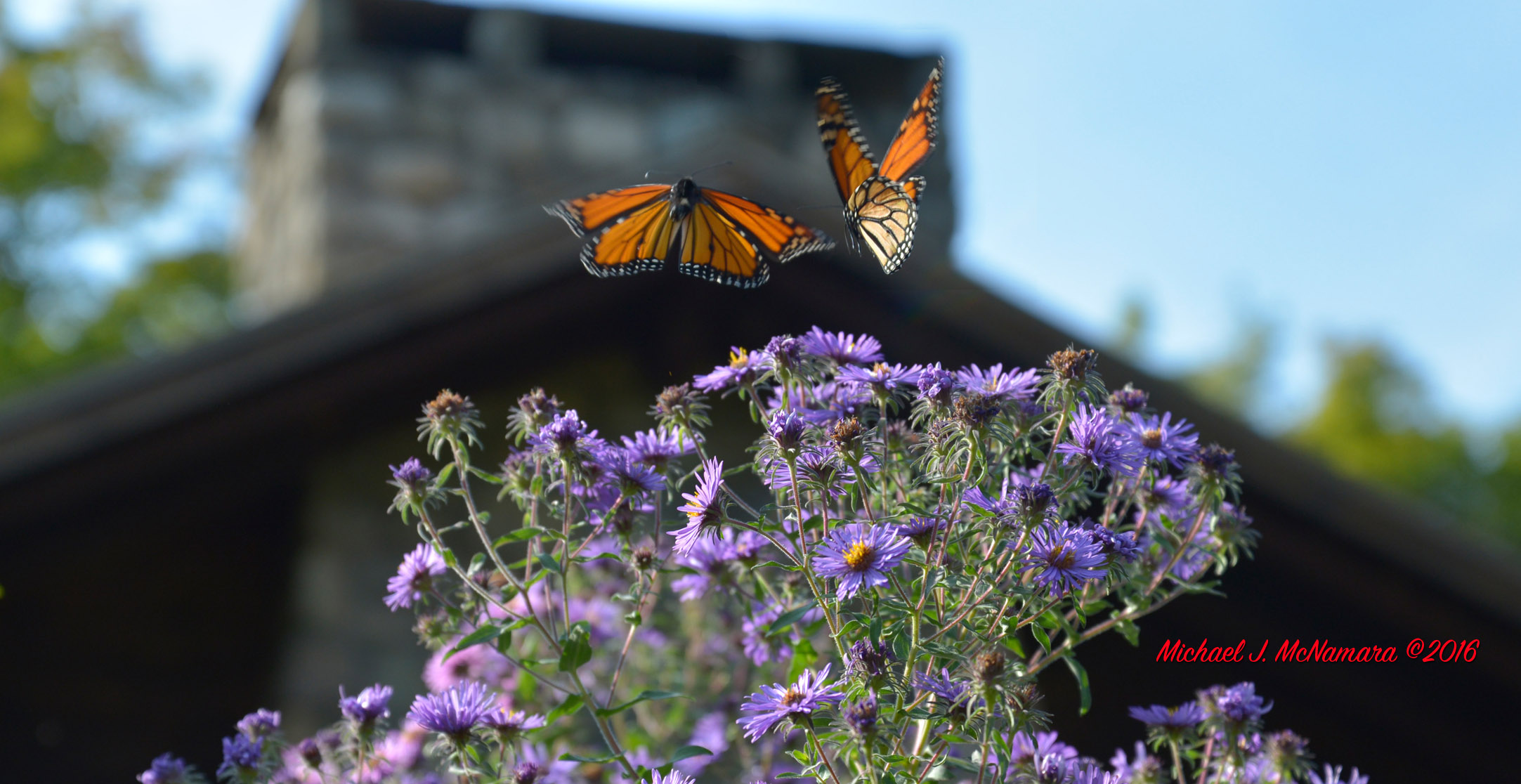
Hidden Treasure: Two male Monarch Butterflies dance in the air at the Anne Odell Butterfly Garden located behind the Hubbard Lodge in Fahnestock State Park, NY.
For over a decade I’ve been a fan of a small, peaceful butterfly garden located a few miles East of Coldspring, NY. The garden was built as a memorial to Anne Odell in 2003 after the Odell family donated the century-old Hubbard Lodge and a large parcel of land to NY, significantly expanding the Clarence Fahnestock Memorial State Park on its North-Western edge. Many of my favorite photos from here can be viewed in the portfolio at the end of this story.
SCROLL TO BOTTOM OF PAGE TO ENTER PORTFOLIO
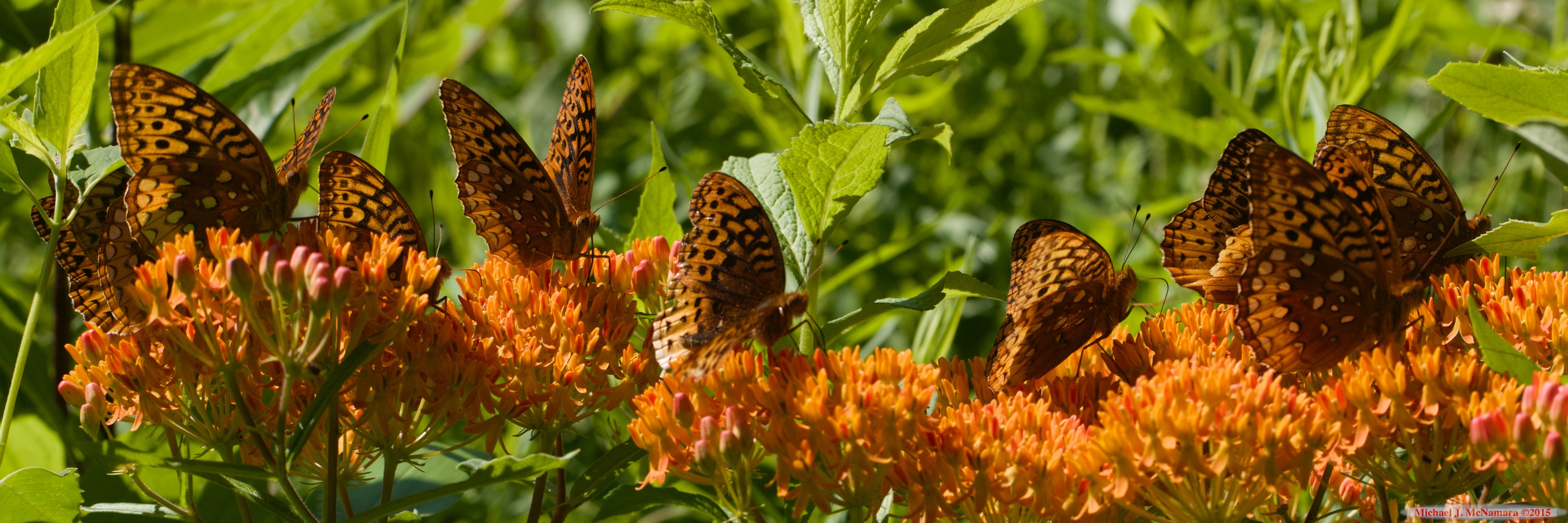
Flotilla of Fritillery: A multitude of Great Spangled Fritillary butterflies (nearly 2 dozen on full flower) captured in a feeding frenzy on a potent Orange Butterfly Weed in the Anne Odell Butterfly Garden, July 2, 2015.
MAGIC ORANGE BUTTERFLY WEED: On July 2, 2015 I witnessed an extraordinary event occur in this garden. As I was walking toward the center of garden (mostly bare of flowers at that time of year) I saw what appeared to be a large handful of leaves being thrown straight up in the air about 20 feet in front of me. But as these “leaves” started flying around I realized they were actually dozens of startled Great Spangled Fritillary butterflies (Speyeria cybele). What happened next was amazing. Within seconds the entire group dropped back down and out of sight. I don’t know about you, but that’s not something I see every day, nor have I ever seen during the decades I’ve hiked and photographed nature in the Hudson Valley. As I slowly moved closer, I discovered that all of the butterflies had returned to a bright orange flowering plant and were in the midst off a feeding frenzy. In fact, they were so hooked on the nectur from the flowers that the majority of the butterflies barely notices me inching closer until I was only a few feet away–enabling me to capture an amazing array of close-up photos and 4K video (click to see one) of this unusual gathering, which I often describe as a “Flotilla of Fritillary“.
CHALLENGE: If you can come up with a better name for a large gathering of butterflies than “Flotilla”, I’d love to hear it!
Needless to say, I had never seen anything like this in all the decades that I have lived in the Hudson Valley. At the height of the gathering, I counted 22 Fritillary feeding on the flowers at once (on a set of flowers measuring about 2 x 1.5 feet), and noticed that every time one butterfly had its fill and left, others waiting on nearby Cone Flowers would fly in to take its place. This event repeated itself every afternoon for the next a week, albeit with fewer butterflies joining the frenzy as the nectar in the flowers ran dry. )
In the Fall of 2015 I returned to harvest some seed pods from the Mother Plant (or Queen as I nicknamed it), hoping to someday attract my own Flotilla of Fritillary in my flower gardens. According to most research, the Orange Butterfly Weed (a milkweed plant) usually starts blooming in its second year, so I wasn’t expecting any “Flotilla’s” in my garden in 2016. However, you can’t imagine my joy when I started seeing female Monarch Butterflies laying eggs on the seedlings in mid-July, when the new plants were only 10-12 inches tall. They appeared to favor this plant, ignoring the larger swamp milkweed plants I had growing around the garden.
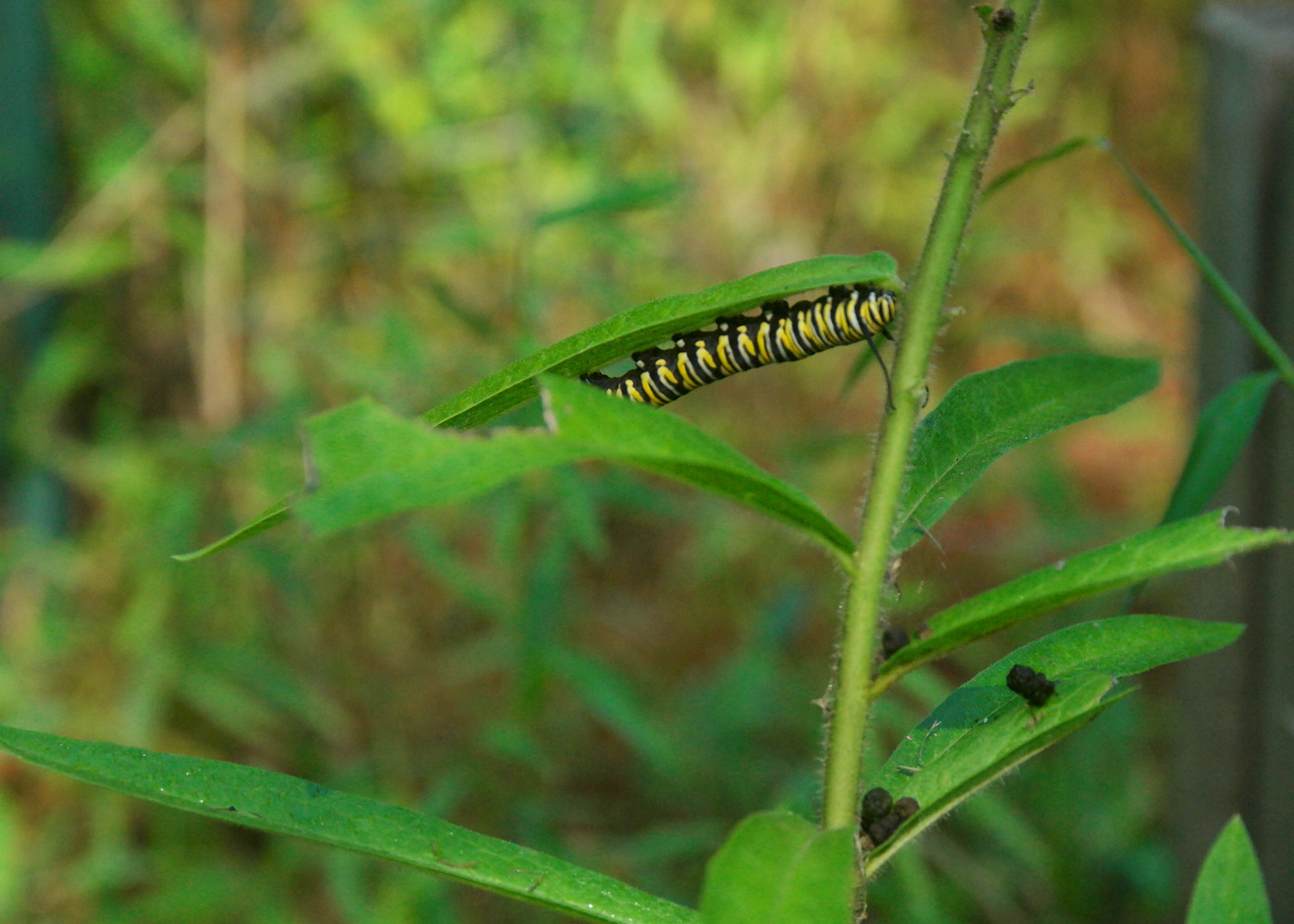
In July of 2016, a year before they flowered, I found over a dozen Monarch Caterpillars on the seedlings from the Orange Butterfly Weed.
By mid-August of 2016 I had nearly a dozen Monarch caterpillars munching on as many seedlings in a 4 x 4 area of my garden. These became the stars of several time-lapse videos I shot in my studio showing the caterpillar transforming into a chrysalis, and 14-15 days later emerging from the crysalis as a butterfly in the process known as Eclose. To see this fascinating metamorphosis, watch “Monarch Butterfly Metamorphosis From Egg To Eclose”.
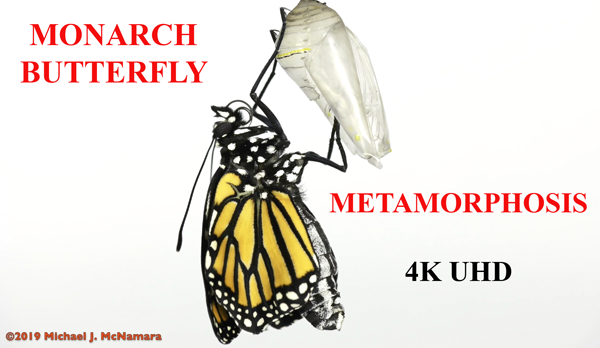
Click on the image or link above to watch movie. Several scenes shot in Anne Odell garden. https://youtu.be/exD9ZuVUJIM
Since my first success at raising Monarch Butterflies, I’ve dedicated more and more of my vegetable garden to growing Orange Butterfly Weed. or as I call it, “baby-food” for Monarch Caterpillars. Ok, I don’t raise the plants entirely as a food source for the butterflies and caterpillars because, as a bonus, I get to enjoy watching and photographing the dozens of Fritillaries, Swallowtails, Monarchs, Clearwing Moths, hummingbirds, and other pollinators feast on the pretty orange flowers throughout the Summer. Something about the nectar in this plant tends to slow down even the most active Black Swallowtails and hummingbirds, allowing me to get closer with my camera than usual.
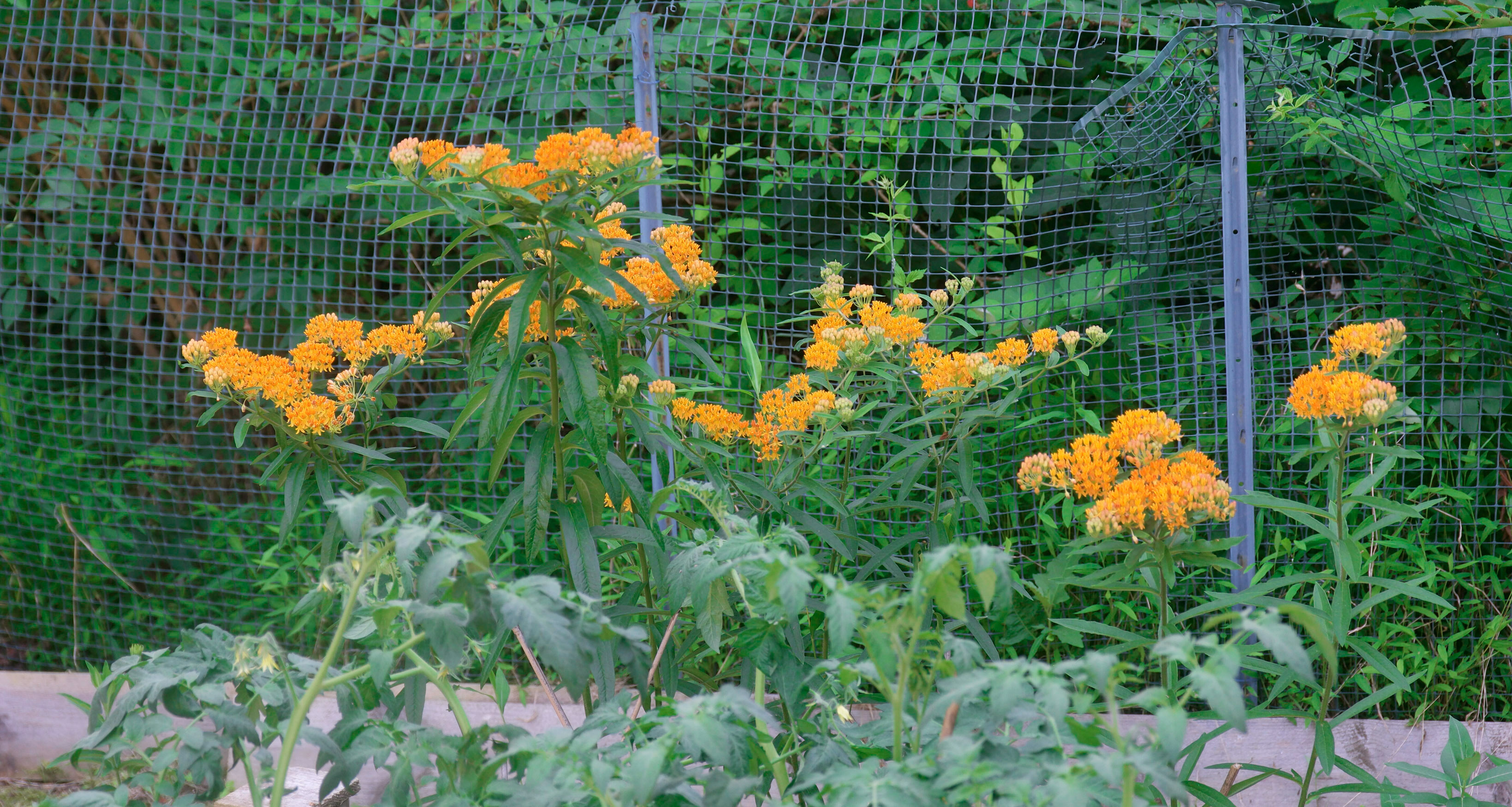
Descendants of the Orange Queen as they flowered for the first time in the back of my tomato garden in July of 2017.
The Orange Queen in the Anne Odell Butterfly Garden has continued to attract groups of Fritillary butterflies to it every year since, but never as many as I saw in 2015. It always blooms around the first day in July and holds flowers till early August. When grown in a garden, this plant will regenerate flowers that are deadheaded (or cut for decoration) and will provide food source for Monarchs and other pollinators well into the Fall.
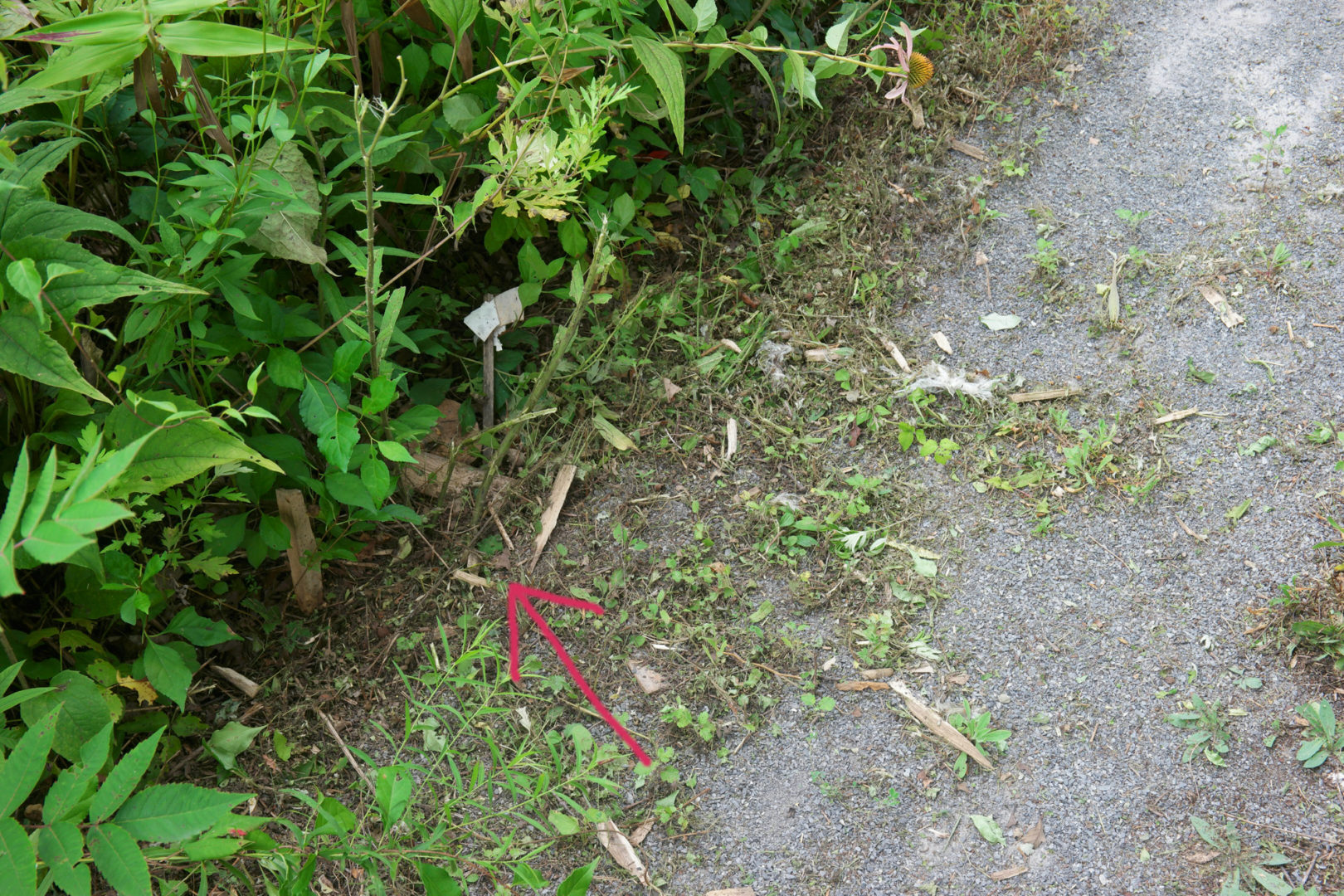
Cut Down Damage In 2017. Widening a trail in a butterfly garden is tricky work, and accidents can happen. Arrow above shows where plant lives, surrounded by wooden shards from the small fence that had been around it before a lawnmower cut it all down while widening the walking path. Fortunately, with a little TLC the plant did well in 2018.
2021 UPDATE: In 2018 and 2019 the Mother Plant thrived and by the Fall had generated several seed pods, some of which I harvested and planted in my home gardens and gave to friends as gifts. In 2020 I donated seeds from this plant to Fishkill Farms in Hopewell Junction, NY, a well-respected organic farm and farm market located about 5 miles (as the crow flies) from the Anne Odell Butterfly Garden. The farm planted over 100 seedlings in parallel rows, and by mid-August nearly all were flowering–a testament to the right soil and the direct sunlight these plant thrive in. (They don’t like wet clay, cedar mulch, or orange aphids .)
By August of 2020 the Butterfly Weed plants at Fishkill Farms proved to be magnets for egg-laying female Monarch Butterflies. As a result, by early September there were dozens of Monarch Caterpillars on these plants (I counted 23 large ones in a single day)–far more in a concentrated area than anyone at the farm had seen despite establishing Swamp Milkweed outcroppings to attract and breed Monarchs.
This year, (2021) nearly all of the Orange Butterfly Weed plants at Fishkill Farms emerged in early May with signs of strong 2nd year growth. The farm also plans to plant smaller outcroppings around the farm in order to attract and breed more Monarchs while bolstering its own seed bank.
Update Update: Recently, (early May, 2021), NY State began upgrading the Anne Odell Butterfly Garden by adding beautiful new fencing, cutting down invasive vines and plants, adding edging around the trails, and cultivating the flower gardens. The mother plant appears to be doing incredibly well, and should be back to showing off its true colors by the 4th of July.
NOTE: Did I forget to mention that the roots from the Orange Butterfly Weed are known as Pleurisy Root, and is one of the first medicinal plants shared by indigenous Indian tribes with early European settlers? It’s well known as an herbal remedy for treating pleurisy, hacking coughs, hardened mucous in the lungs, and other lung ailments. PS: It was registered as a U.S. Pharmaceutical until the early 1900s, and coincidentally sold out across the U.S. by May of 2020 during the Covid 19 epidemic.
TO VIEW PHOTOS FULL SCREEN, CLICK ON THEM.
All Photos ©Michael J. McNamara 2015-2019